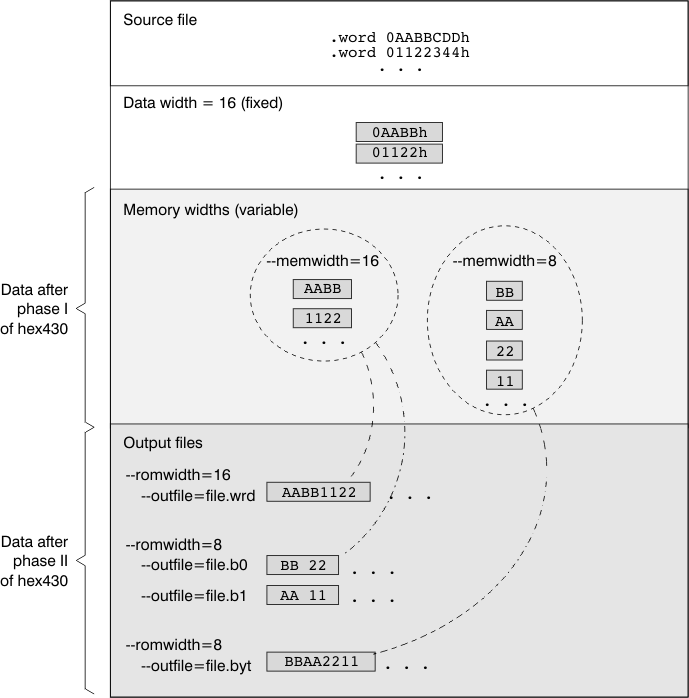SLAU131V October 2004 – February 2020
12.3.3 Partitioning Data Into Output Files
ROM width determines how the hex conversion utility partitions the data into output files. ROM width specifies the physical width (in bits) of each ROM device and corresponding output file (usually one byte or eight bits). After the object file data is mapped to the memory words, the memory words are broken into one or more output files. The number of output files is determined by the following formulas:
- If memory width ≥ ROM width:
- If memory width < ROM width:
number of files = memory width ÷ ROM width
number of files = 1
For example, for a memory width of 16, you could specify a ROM width value of 16 and get a single output file containing 16-bit words. Or you can use a ROM width value of 8 to get two files, each containing 8 bits of each word.
The default ROM width that the hex conversion utility uses depends on the output format:
- All hex formats except TI-Tagged are configured as lists of 8-bit bytes; the default ROM width for these formats is 8 bits.
- TI-Tagged is a 16-bit format; the default ROM width for TI-Tagged is 16 bits.
NOTE
The TI-Tagged Format is 16 Bits WideYou cannot change the ROM width of the TI-Tagged format. The TI-Tagged format supports a 16-bit ROM width only.
NOTE
TI-TXT Format is 8 Bits WideYou cannot change the ROM width of the TI-TXT format. The TI-TXT hex format supports only an 8-bit ROM width. See Section 12.13.6 for more about using the ROMS directive with the TI-TXT hex format.
You can change ROM width (except for TI-Tagged and TI-TXT formats) by:
- Using the --romwidth option. This option changes the ROM width value for the entire object file.
- Setting the romwidth parameter of the ROMS directive. This parameter changes the ROM width value for a specific ROM address range and overrides the --romwidth option for that range. See Section 12.4.
For both methods, use a value that is a power of 2 greater than or equal to 8.
If you select a ROM width that is wider than the natural size of the output format, the utility simply writes multibyte fields into the file. The --romwidth option is ignored for the TI-TXT and TI-Tagged formats.
Figure 12-4 illustrates how the object file data, memory, and ROM widths are related to one another.
